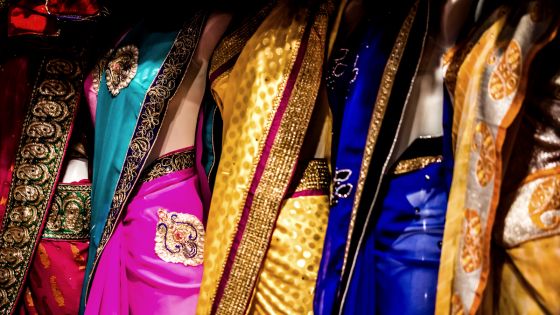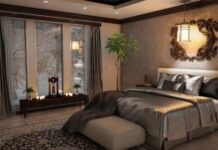The Kashmiri embroidered saree is a beautiful and intricate piece of clothing that reflects the rich cultural heritage of the Kashmiri people. These sarees are handcrafted by skilled artisans using a variety of techniques that have been passed down through generations. One of the most distinctive features of the Kashmiri embroidered saree is the intricate embroidery that covers the fabric. The embroidery is typically done using silk thread and features floral and paisley motifs that are inspired by the natural beauty of the region. The embroidery is often done in shades of blue, green, and red, creating a stunning contrast against the white or cream-colored fabric. Another key feature of the Kashmiri embroidered saree is the use of high-quality fabrics. The sarees are typically made using fine, lightweight materials like chiffon, georgette, or silk, which drape beautifully and add to the overall elegance of the garment. The use of high-quality fabrics also ensures that the sarees are durable and long-lasting, making them a valuable addition to any wardrobe. In addition to the embroidery and fabric, the Kashmiri embroidered saree is also known for its unique drape.


The saree is typically worn with a pleated pallu that is draped over the shoulder, and the embroidered border is left to hang freely. This gives the saree a graceful and flowing look that is both elegant and feminine. The Kashmiri embroidered saree has a long and rich history, dating back to the Mughal era in India. During this time, the region of Kashmir was renowned for its textiles and embroidery, which were highly prized by the Mughal emperors. Over time, the art of Kashmiri embroidery evolved and became more refined, with different techniques and styles emerging to suit the changing tastes and fashions of the time.
Today, the Kashmiri embroidered saree remains a popular choice for women all over the world. Its unique beauty and elegance have made it a favorite among brides, and it is often worn during weddings and other special occasions. The saree is also a popular choice for formal events, such as parties and receptions, where its graceful drape and intricate embroidery make it a standout garment. In recent years, there has been a growing interest in sustainable and ethical fashion, and many designers and brands are now creating Kashmiri embroidered sarees using eco-friendly and socially responsible practices. This includes the use of organic and sustainable fabrics, as well as partnering with local artisans and craftspeople to ensure fair and ethical working conditions. The Kashmiri embroidered saree is a beautiful and timeless piece of clothing that reflects the rich cultural heritage of the Kashmiri people. Its intricate embroidery, high-quality fabrics, and unique drape make it a standout garment that is both elegant and feminine. As the fashion industry continues to evolve, the Kashmiri embroidered saree will undoubtedly remain a cherished and beloved garment for generations to come. The Kashmiri embroidered saree is not just a piece of clothing, but a work of art. Each saree is handcrafted with care and attention to detail, making each piece unique and special. The embroidery itself is done using a variety of techniques, including chain stitch, satin stitch, and crewelwork, which require a high degree of skill and precision. One of the most fascinating aspects of the Kashmiri embroidered saree is the history and symbolism behind the motifs used in the embroidery. For example, the paisley motif is a common feature in Kashmiri embroidery and is believed to have originated in the region. The paisley symbolizes the cypress tree, which is an important symbol in Persian and Islamic art and represents eternal life and fertility. Similarly, the chinar leaf motif is another popular design in Kashmiri embroidery. The chinar tree is a common sight in the region and is considered a symbol of life and prosperity. The use of such motifs not only adds to the beauty of the saree but also reflects the cultural heritage and history of the Kashmiri people. The Kashmiri embroidered saree is not just a piece of clothing, but also an expression of identity and pride for the women who wear it. It is a symbol of their cultural heritage and a testament to the rich artistic traditions of the region. For many women, wearing a Kashmiri embroidered saree is not just about looking good but also about feeling connected to their roots and preserving their cultural heritage.
In recent years, there has been a growing interest in reviving and preserving traditional crafts and arts, including Kashmiri embroidery. Many designers and brands are now working with local artisans and craftspeople to create contemporary designs that incorporate traditional embroidery techniques and motifs. This has not only helped to preserve traditional skills and knowledge but also provides a livelihood for the artisans and promotes sustainable and ethical fashion practices. The popularity of Kashmiri embroidered sarees has spread beyond the borders of India, with women all over the world embracing this elegant and timeless garment. From Hollywood celebrities to fashion influencers, the Kashmiri embroidered saree has found its way into the wardrobes of women of all ages and nationalities. One of the reasons for the popularity of Kashmiri embroidered sarees is their versatility. They can be worn to formal events like weddings and parties, as well as more casual occasions like dinners and gatherings. They can be dressed up or down, depending on the occasion and personal style, making them a versatile addition to any wardrobe. Another reason for the popularity of Kashmiri embroidered sarees is their durability. Due to the use of high-quality fabrics and the intricate embroidery techniques, these sarees can last for many years, making them a valuable investment for any fashion-conscious woman. It is therefore important for designers and brands to approach the use of traditional crafts and techniques with sensitivity and respect, and to work with local artisans and craftspeople to ensure that their rights and interests are protected. This not only ensures the sustainability and preservation of traditional crafts but also promotes ethical and responsible fashion practices.















